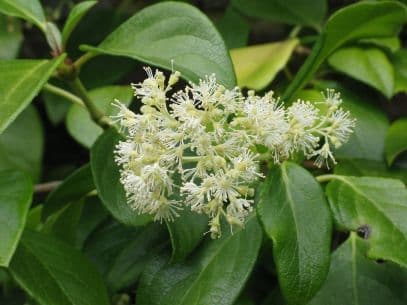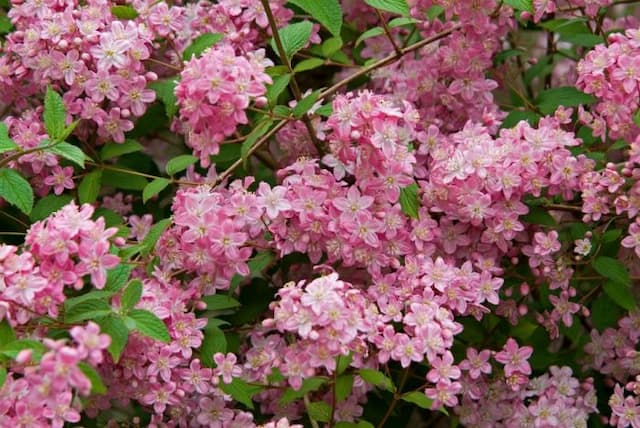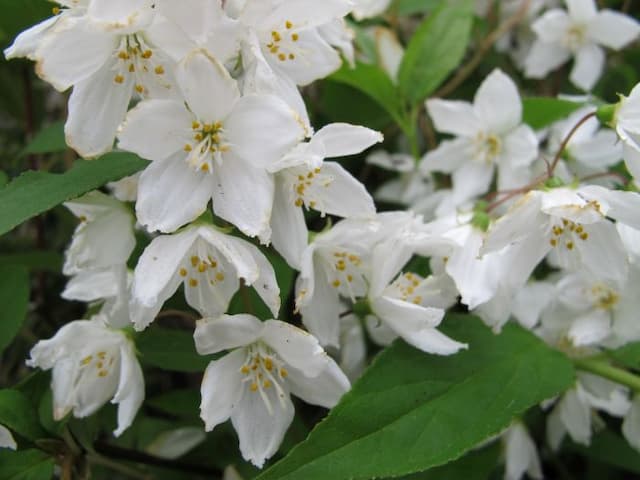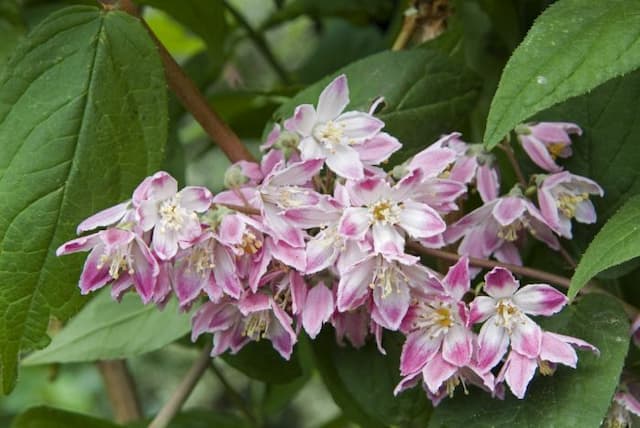Hydrangea Hydrangea macrophylla Blackberry Pie = 'Makz' (Flair & Flavours Series) (L)
![hydrangea [Blackberry Pie]](/_next/image?url=https%3A%2F%2Fplants-admin.emdemapps.com%2Fimages%2Fplants%2F%2Fimages%2F604b56e2abc1d.png&w=3840&q=75)
ABOUT
The Hydrangea Macrophylla Blackberry Pie, known from the Flair & Flavours Series as 'Makz', boasts a striking appearance with lush foliage and large, rounded flower heads. The leaves are typically deep green, providing a rich backdrop for the flowers. These blooms are the main attraction, presenting a mix of deep purple and blue hues, often with a gradient effect that suggests a pie filling of ripe blackberries. The blossoms can sometimes show hints of pink or red as well, with each individual flower displaying a variation in color intensity, giving the plant an opulent and varied look. The petals have a full, slightly ruffled texture, adding to the overall plushness of the flower clusters. These recurring blooms provide a decadent display of color throughout the blooming seasons.
About this plant
 Names
NamesSynonyms
Blackberry Pie Hydrangea, Bigleaf Hydrangea Blackberry Pie, Hortensia Blackberry Pie.
Common names
Hydrangea macrophylla 'Makz'.
 Toxicity
ToxicityTo humans
Hydrangea, including the 'Blackberry Pie' variety, contains compounds known as cyanogenic glycosides, which can release cyanide when chewed or digested. Poisoning from hydrangeas is rare, but if parts of the plant are ingested in large enough quantities, symptoms could include stomach upset, nausea, vomiting, and diarrhea. In some cases, more severe symptoms might present, such as dizziness, difficulty breathing, or convulsions, but such extreme reactions are uncommon. If suspected poisoning occurs, medical attention should be sought promptly.
To pets
Hydrangea is toxic to pets due to the same cyanogenic glycosides found in the plant. When ingested by pets, such as dogs or cats, it can lead to gastrointestinal distress, including symptoms like vomiting, diarrhea, and lethargy. Depending on the amount ingested, it could also potentially result in more serious signs like depression or confusion. If you suspect your pet has ingested hydrangea, you should contact a veterinarian immediately to receive appropriate care and guidance.
 Characteristics
CharacteristicsLife cycle
Perennials
Foliage type
Deciduous
Color of leaves
Green
Flower color
Varies
Height
4-5 feet (1.2-1.5 meters)
Spread
4-6 feet (1.2-1.8 meters)
Plant type
Shrub
Hardiness zones
5-9
Native area
Asia
Benefits
 General Benefits
General Benefits- Ornamental Value: Hydrangeas are popular for their large, colorful blooms which make them a focal point in any garden.
- Seasonal Interest: They bloom from early summer to fall, providing long-lasting color and interest.
- Landscape Versatility: They can be planted in the ground or containers, and are suitable for a variety of garden styles, from informal cottage gardens to formal arrangements.
- Shade Tolerance: Hydrangeas can thrive in partial shade, offering a flowering option for less sunny spots.
- Suitable for Cutting: The flowers are excellent for cutting and using in fresh floral arrangements.
- Attracts Pollinators: The flowers attract bees and butterflies, which are beneficial for pollination of other plants in the garden.
- Ease of Care: Hydrangeas are generally easy to care for, requiring minimal maintenance beyond regular watering and occasional pruning.
- Variety of Colors: The 'Blackberry Pie' variety offers unique bloom colors that can shift from blue to pink to purple depending on soil pH.
 Medical Properties
Medical PropertiesThis plant is not used for medical purposes.
 Air-purifying Qualities
Air-purifying QualitiesThis plant is not specifically known for air purifying qualities.
 Other Uses
Other Uses- Photography Prop: The striking blooms of the Hydrangea can be used to add a touch of elegance and rich color to still-life photography or as a backdrop for portrait sessions.
- Art Inspiration: Artists may draw inspiration from the intricate shapes and vibrant colors of Hydrangea flowers for their paintings, drawings, or textile designs.
- Culinary Garnish: While not a common practice, the petals of Hydrangeas—though slightly bitter—can sometimes be used as a unique and decorative garnish on certain desserts or dishes.
- Dried Flower Arrangements: Hydrangea flowers can be dried and used in long-lasting floral arrangements, providing a rustic and vintage look to interior decorations.
- Color Indicator: The flower’s color can change based on the soil pH, which can be an interesting way to experiment with natural pH indicators in educational contexts.
- Handicrafts Material: The wood of the Hydrangea plant can be used in crafting small items such as picture frames or jewelry, showcasing its natural beauty in a different form.
- Fabric Dyeing: The petals of the Hydrangea can be used in the process of fabric dyeing to produce subtle color variations, useful in creating unique textile art.
- Wedding Decor: Hydrangea flowers are often used in wedding bouquets and venue decorations, providing lush, voluminous arrangements that enhance the romantic setting.
- Nature Crafts: The blooms and leaves of the Hydrangea can be used in nature crafts, such as pressed flower projects, to create bookmarks, cards, or decorative pieces.
- Education: The plant can be used as a tool in schools or educational programs to teach students about botany, especially the principles of flowering and growth in angiosperms.
Interesting Facts
 Feng Shui
Feng ShuiThe hydrangea is not used in Feng Shui practice.
 Zodiac Sign Compitability
Zodiac Sign CompitabilityThe hydrangea is not used in astrology practice.
 Plant Symbolism
Plant Symbolism- Heartfelt Emotions: Hydrangeas often symbolize heartfelt and genuine emotions. The richness of the 'Blackberry Pie' variety's hue can represent the depth and intensity of these feelings.
- Gratitude: The giving of hydrangeas, including the 'Blackberry Pie' variety, is a way of saying thank you for being understood, often associated with their abundant star-shaped flowers that form the large head of the plant.
- Apothecary's Sign: Historically, hydrangeas were a symbol of an apothecary, due to their extensive use in folk medicine, which carries over to modern varieties such as 'Blackberry Pie'.
- Vanity: In certain cultures, hydrangeas also carry a negative connotation of vanity or boastfulness, potentially owing to their showy and large blooms, including those of the 'Blackberry Pie'.
- Perseverance: These plants can thrive in a variety of soil conditions, which can symbolize endurance and the ability to overcome adversity, a trait shared by the resilient 'Blackberry Pie' hydrangea.
 Water
WaterBigleaf hydrangeas, like the Hydrangea macrophylla 'Blackberry Pie', require consistent moisture and should be watered about 1 inch per week, either from rainfall or manual watering. During hot or dry weather, this may increase to 2 inches per week. It's essential to water deeply and thoroughly to encourage root growth. Water at the base of the plant to avoid wetting the foliage, which can lead to fungal diseases. In the absence of rain, provide supplemental water using a soaker hose or drip system early in the morning, which will ensure the water reaches the roots and minimizes evaporation.
 Light
LightBigleaf hydrangeas, such as the 'Blackberry Pie', thrive in morning sun with afternoon shade, or dappled sunlight throughout the day. The ideal spot for this plant would be in a location where it is protected from the intense afternoon sun, particularly in hotter climates. Too much direct sunlight can lead to leaf scorch, while too little light can reduce blooming.
 Temperature
TemperatureBigleaf hydrangeas, like 'Blackberry Pie', prefer temperatures that range between 65°F to 75°F for optimal growth. However, they can tolerate temperatures as low as 50°F and as high as 80°F. They should be protected from sudden frost, which can damage the plant and affect blooming. Providing mulch can help regulate soil temperature and protect the roots during unexpected temperature changes.
 Pruning
PruningBigleaf hydrangeas like 'Blackberry Pie' should be pruned to remove dead wood and to shape the plant immediately after flowering, as they bloom on old wood. Pruning too late in the season can remove flower buds for the following year. Minimal pruning is best, focusing only on dead or crossing branches and spent flowers. Some light shaping can be done to encourage a bushier growth.
 Cleaning
CleaningAs needed
 Soil
SoilThe best soil mix for a Hydrangea, commonly known as Bigleaf Hydrangea, should be rich, moist, and well-draining. A mixture of garden soil, compost, and peat moss provides a good structure. The ideal pH for this hydrangea is slightly acidic to neutral, around 5.5 to 7.0, which influences the bloom color.
 Repotting
RepottingBigleaf Hydrangeas should generally be repotted every 2 to 3 years to ensure they have enough room to grow. They should be repotted in the spring before the growing season starts.
 Humidity & Misting
Humidity & MistingBigleaf Hydrangeas thrive best in environments with moderate to high humidity levels, ideally between 60% and 70%. They may need additional humidity in dry indoor conditions.
 Suitable locations
Suitable locationsIndoor
Place in bright, indirect light; keep soil moist but not soggy.
Outdoor
Plant in partial shade, shelter from strong winds, and mulch soil.
Hardiness zone
5-9 USDA
 Life cycle
Life cycleThe Hydrangea macrophylla Blackberry Pie begins its life as a seed, requiring a period of cold stratification to break dormancy. Once germinated, the seedling emerges and enters a vegetative stage, establishing a root system and producing leaves. As it matures, the plant forms dense bushes with thick foliage, and in the appropriate season, it develops flower buds. The distinctive blossoms of the hydrangea, varying in color based on soil pH, open to display their full glory, attracting pollinators. After the flowering stage, the plant sets seeds, which are either distributed by natural forces or collected for propagation. The hydrangea then enters a period of dormancy during colder months, with its above-ground parts dying back, only to regrow from its perennial root system with the arrival of spring.
 Propogation
PropogationPropogation time
Spring-Early Summer
The most popular method of propagation for the Hydrangea macrophylla 'Blackberry Pie' is through softwood cuttings in early summer. Collect 4 to 6 inch (10 to 15 cm) cuttings from new growth that has not yet flowered, ensuring each cutting has at least three sets of leaves. Remove the leaves from the lower half of the cutting and dip the cut end into rooting hormone powder. Then insert the cutting into a pot filled with moistened potting mix, ensuring that at least two nodes are buried where leaves were removed. Cover the pot with a plastic bag to create a humid environment and place in indirect light. The cuttings typically root in 4 to 6 weeks, after which they can be transplanted into individual pots to grow on before planting out.






![Rose deutzia [Yuki Cherry Blossom]](/_next/image?url=https%3A%2F%2Fplants-admin.emdemapps.com%2Fimages%2Fplants%2F%2Fimages%2F604b6510a383a.png&w=640&q=75)
![Hydrangea [Hot Chocolate]](/_next/image?url=https%3A%2F%2Fplants-admin.emdemapps.com%2Fimages%2Fplants%2F%2Fimages%2F604b5a066e3bd.png&w=640&q=75)

